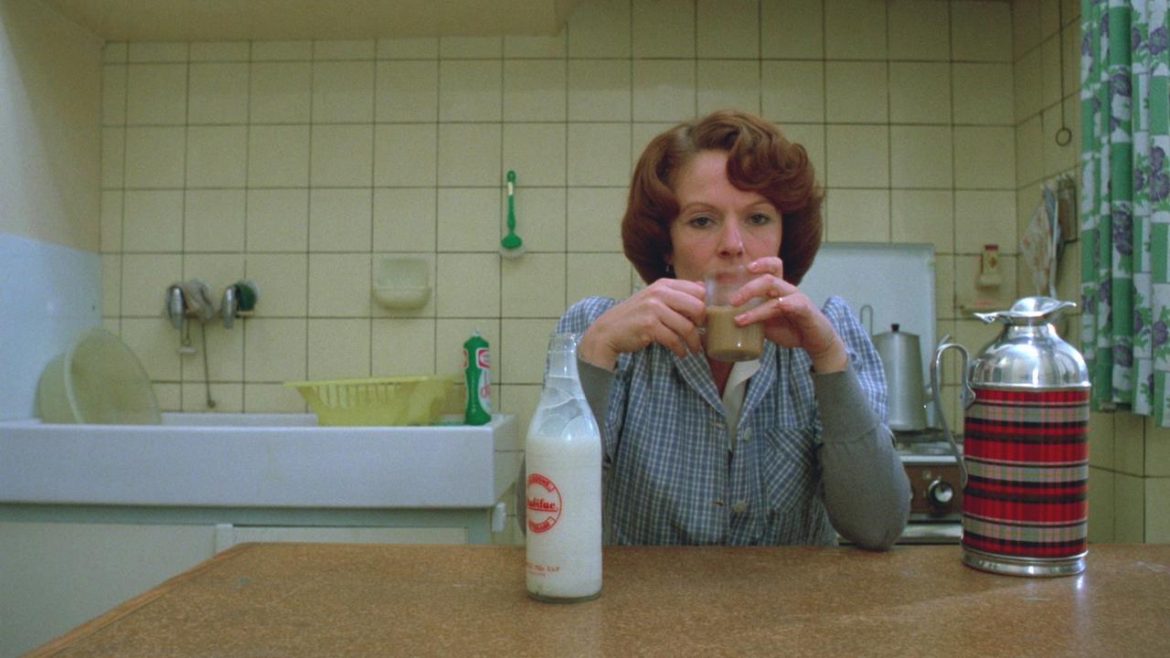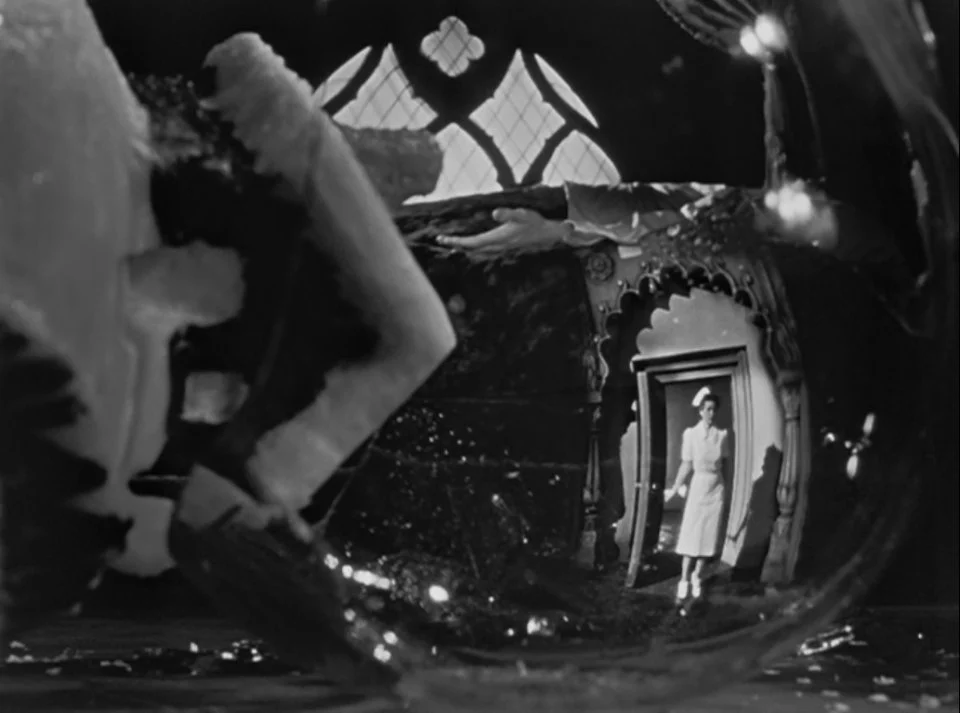The pain of genuine faith haunts much of Andrei Tarkovsky’s work. His
characters can often be found soaking in misery and desperation. In
many ways, they are lost. Their faith has not brought them comfort,
security or riches. Some are outcasts at the fringes of society, others
are even seen as insane. In Tarkovsky’s word faith is hard and can come
at great personal cost.
In one of the pages of his diaries, published under the title “Time
Within Time”, he had drawn a cross and written the following: “What can I
do? Only pray! And believe. The most important thing of all is this
symbol, which it is not given to us to understand, only to feel. To have
faith in spite of everything; to have faith.”
This view of holding faith in spite of everything may be the key to
understanding how and why Tarkovsky would explore faith the way he did.
The religious undertones are clear, as is the imagery, but the miracles
are only implied. The worlds Tarkovsky crafts are not worlds of
clear-cut miracles or easy answers. Rather, we are offered a choice: we
can find the miracles within his works, or we can find a natural
explanation. In the end, it comes down to faith, despite all.
In this article, we will take a closer look at how this is put into
practice in the four films by Tarkovsky that explore this in the
greatest detail, namely Andrei Rublev (1965), Stalker (1979), Nostalghia (1983) and The Sacriface
(1986), and look at how, as his career continued and grew to a close,
the worlds he crafted became even more hostile to his men of faith –
while the stakes, also grew – to the point that the fate of the entire
world could be at stake.
The First Genuine Experience of Tarkovsky’s Exploration of Faith

Andrei Rublev is arguably the first true Tarkovsky film.
This is the film he fought to get made, and it is where we see him
develop many of the visual and thematic ideas we will know from his
later work. Most notably, this is the first time we see Tarkovsky’s
exploration and interrogation of faith, and not just of its pious
titular character, but of the audience’s faith as well.
The most important moment comes towards the end of the final act,
where we have followed a young bell-maker, Boriska, placed in charge of
constructing a new bell for the church at the peril of death if it
fails. He starts reassured but slowly gets more and more anxious,
something Rublev, now under a vow of silence, quietly observes.
It is only once the bell is finished and revealed in all its beauty
and perfection that Boriska breaks down in Rublev’s arms. Crying,
Boriska reveals that he had lied. He was not a true bell-maker. His
father, dead from the plague, had not passed on his craft. He had lied
in the face of hunger and taken on a task he was sure would leave him
dead. The bell is magnificent, against all odds.
Without it ever being stated or made clear there is a very strong
sense that a miracle has taken place. That the prayers of Rublev have
been answered. That this is the miracle work of a saint.
It is a pivotal note to leave our story on, cutting then to the
artworks of Andrei Rublev, in great colours. The sense of miracle
looming and yet, nothing against the forces of nature has actually been
shown on screen. Other explanations for the success, such as the craft
of his father’s team, are without a doubt functional readings of what
has just occurred. Tarkovsky may guide your hand, both in imagery and
massaging but in the end, what happened is for you to decipher.
The Rules and Magic in the World of Stalker
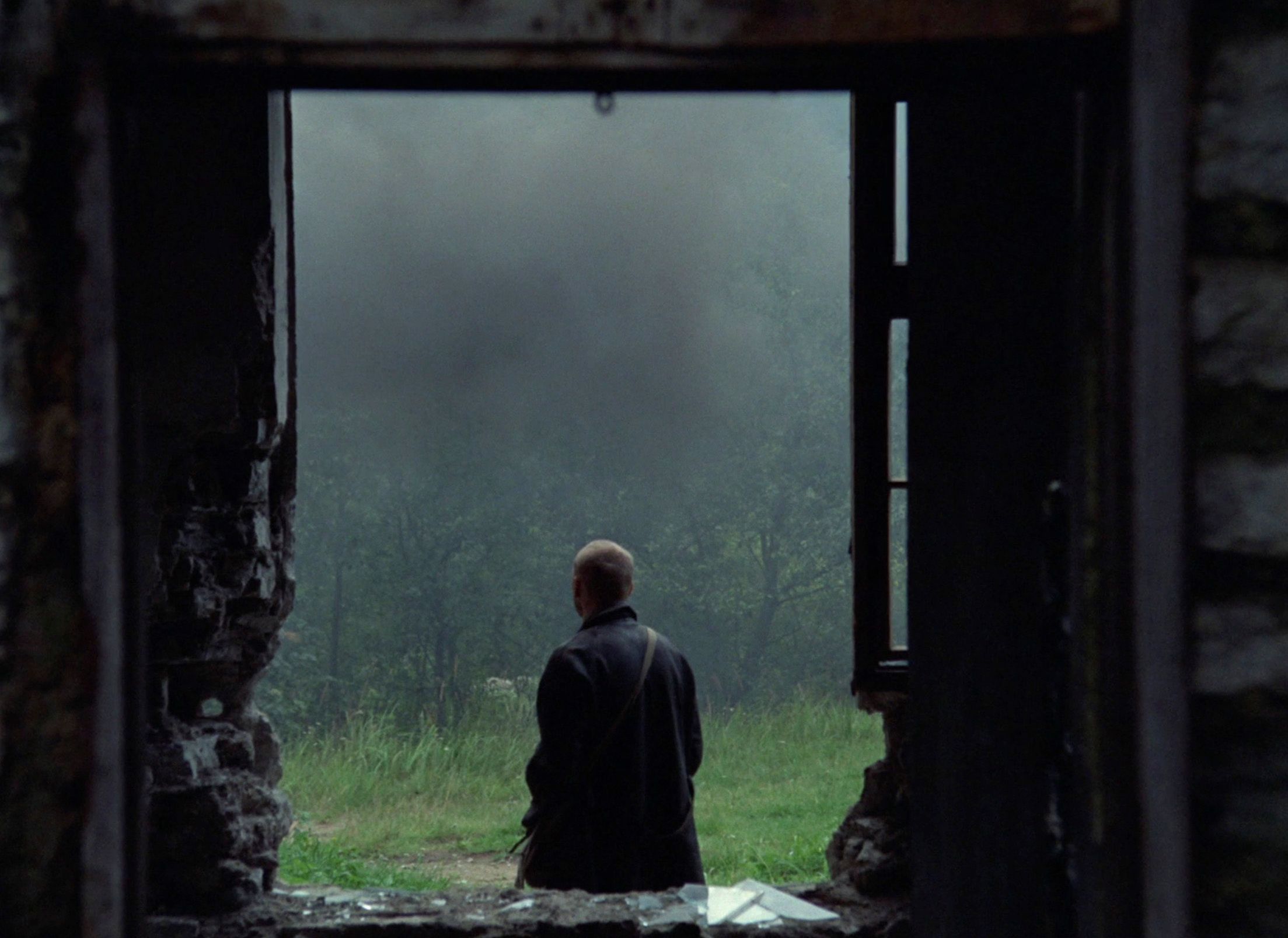
While faith plays a role in both Solyaris and Mirror, it is not as clearly at their core, at least not in the same way as in Andrei Rublev and Tarkovsky’s final set of three films. We, therefore, leap forth to Stalker,
where we are not investigating Christianity, but the spiritual stand-in
of the Zone; a military-guarded area of unknown properties.
The stalkers – spiritual guides through this green wasteland – hold
that the Zone has a life of its own, has its own rules, and must be
treated with respect. Their role is to maintain their rituals and safely
lead others to a form of grace and salvation in the form of the
mysterious “room” deep inside the Zone. In this room, it is said, your
innermost wish will come true.
The specific stalker we encounter is a broken man, leading a poor and
wretched life. He has already served time in prison for breaking into
the Zone, and while he has promised his family he’ll quit, he cannot
stop himself. He is tragically drawn to the Zone. It is where he finds
purpose, where he can breathe.
One of the greatest joys in Stalker is simply being within
the world of the Zone, observing the rituals, and wondering about their
actual validity. Is there danger in stepping outside of the given path?
Does the nut with a ribbon, which the stalker will throw ahead to ensure
a safe passage, really doing anything? When an unknown voice speaks to
the “Writer”, is it one of the three men or is it perhaps the Zone
itself?
In their entire time in the Zone, no mystical event is ever shown.
All the suspense comes from believing there is danger – and the corpses
in their path certainly increase the sense of death and doom.
When they reach the room, neither of the two men the stalker has
brought chooses to enter the room. Defeated they remain seated outside,
perhaps too awestruck to dare enter, perhaps believing it pointless or
perhaps trapped in the space between belief and disbelief, a space many
of Tarkovsky’s key works seem to occupy or place their characters. They
return home to their grey world with nothing accomplished.
As the stalker enters his small apartment he collapses in tears. He
can’t believe people lack faith, and what’s more, he doesn’t think
people need faith, and this is more tragic for him than anything else –
but why? Is it because it is the only way he can feel respected,
important, or that he has a purpose – or is it because what he believes
has genuine power and beauty?
This scene can be read in so many ways, but this is not where the
film ends. The true ending is one of possible revelation and it is
undoubtedly one of the most memorable scenes in the film. We see the
stalker’s daughter seated at a table and as she looks at the glasses in
front of her, they start to move. Is she moving them with her mind? Is
it true then, that the Zone possesses some kind of energy and power and
that those exposed to it will pass it to their children?
In the very first scene of Stalker, we saw glasses also
start to move as the family slept in bed, but then it was made to seem
as if it was the train close to their home moving it as soon everything
is shaking and you hear the victorious music. Here, there seems to be no
other reason, but then, yet again, we start to see everything shaking.
The train passes by.
Was it the ripples from the train that started to move the glasses? What do we choose to believe?
With this, the sceptics still have something to cling to, and a
reading of the film where there is nothing outside of the natural order
in the Zone – but then, is that a leap of faith of its own?
The Borders of Sanity and Nostalghia
The next step in Tarkovsky’s evolution of looking at faith is to
examine the extent to which genuine faith tests or crosses the borders
of sanity. Here we find a poet named Andrei (a possible standing for
Tarkovsky himself, or perhaps his father) encounter a social recluse the
world has deemed mad. Interestingly, Tarkovsky does little to persuade
us otherwise and nor does actor Erland Josephson. His Domenico seems
incoherent, rambles and does not act as we expect a sane person would.
He does, however, embody a great deal of genuine pain.
Andrei starts to see something in Domenico the others around him do
not, stating that even in his madness he is “closer to the truth than
us”. However, the audience gets no real indication this could be the
case.
This fascination soon brings him face to face with Domenico, and he
learns of a necessary ritual – taking the burning candle across the old
spring – a task he may or may not take on.
In flashbacks, this possibility is tested further. We first learn
that Domenico kidnapped his wife and child, keeping them trapped for
years – possibly to spare them from sin. We see the heartbreaking scenes
of the police breaking through the door, the wife kissing their feet
and his young son running away – bewildered at what he sees around him
and wondering if it is the end of the world.
To the casual observer, Domenico is not just mentally ill, but
dangerous. His faith and actions are painstakingly painted as contrary
to what we see as sane. This is especially as he takes to the square and
preaches damnation and salvation before setting himself on fire. The
partially botched attempt, where the music fails to work and his
accomplice and audience all seem to border on incompetency and madness
themselves. No one steps in as he burns to death.
Meanwhile, unknowingly to us whether he genuinely believes in his
act, our poet has decided to carry out the ritual. He steps into the
drained spring, lights a candle and starts to walk across. Guffs off
wind puts the light out, and Andrei tries to shield it with his hand or
jacket as the ritual needs to restart time and time again. This build-up
continues until he with shaking hands finally reach the other side,
where he suddenly collapses, quite likely dead.
The sudden implication is that he and Domenica have both given up
their lives, at the very same time. Did their rituals and their flames
save the world from the end of days or is the correlation simply a
coincidence?
Once again, as in Andrei Rublev, there is a sense of miracle
– a sense that something greater has happened – but here the world is
so much darker – and their actions so much closer to what most would
label madness.
And once again, faith and belief enter the equation. The power and
what we take away may very well depend on what we personally believe.
The Act of a Genuine Sacrifice
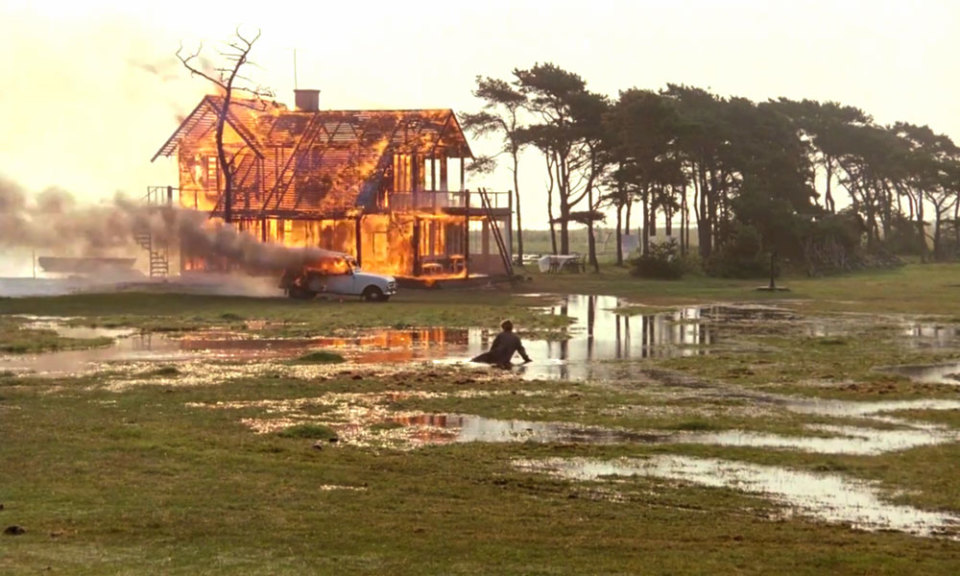
Intriguingly, both Nostalghia and Tarkovsky’s next and final work, The Sacrifice, have characters who make sacrifices to save the world. There is one notable difference though. In Nostalghia the risk is never made clear or showcased in any way, The Sacrifice shows a world on the brink of nuclear war. The risk, at least if we believe what we see on screen, is very much real.
What starts as a fairly regular birthday for Erland Josephson’s
Alexander develops into a nightmare as sudden rifts tear through their
home, causing mayhem. The cinematography changes from vivid colour
photography to having a dark grey tint that could almost make us believe
all are already dead as they watch a TV report that warheads may be
directed at Sweden, but that they are still one of the safest places in
Europe. WW3 may just be afoot and our characters start to break down.
However, while others cry, despair, or brace themselves, Alexander
prays and prays. The verbose man, who spent the first act of the film
monologuing, promises to never speak again and to essentially give up
all he owns as long as his family and particularly his son is saved.
Interestingly, it is not through Christianity but witchcraft that
salvation may come. Alexander’s spiritually-inclined friend, who
collects stories of the unnatural, reveals that he knows of a secret
witch that can set everything right. It is in fact Alexander’s Icelandic
maid. She is their last hope. All can be set well if Alexander lays
with her.
It is a bizarre proposition, but Alexander chooses to believe it.
Following an awkward escape, he bikes to her house, barges in and after a
long monologue she takes pity on him – though seemingly unaware of
everything that has been going on.
As they lay in bed we witness the arguably first and only time we see
something that indisputably goes against the forces of nature on screen
in these 4 films: they start to levitate. After this scene, it is as if
the world has reset. The cinematography is readjusted to light colours
and the greyness is gone as Alexander wakes up in his own home.
Was it all a dream or has he genuinely saved the world?
Regardless of what the truth may be, Alexander remembers his promises
and determines to keep them. He lures his family away and sets his home
on fire, leading to the film’s iconic climax.
His family and friends run to him, but as he is about to explain
himself he remembers his vow of silence and refuses to speak. An
ambulance takes him away, as if mad, and once again, the idea of madness
is very much present. Is what we have seen the acts of a rational man?
Is it this sacrifice that will ensure the safety of his son?
People of faith bargaining with their gods is a common motif in art,
not to mention real-world practice, but here we see the consequences of
what would be if someone truly went through with keeping their promises.
Would that act in itself be mad – and once again, has a miracle or
something outside of the realms of what we know as the natural world
taken place?
Once again, Tarkovsky leaves this question to us, and once again what you believe happened will be a question of faith.
Belief Despite All
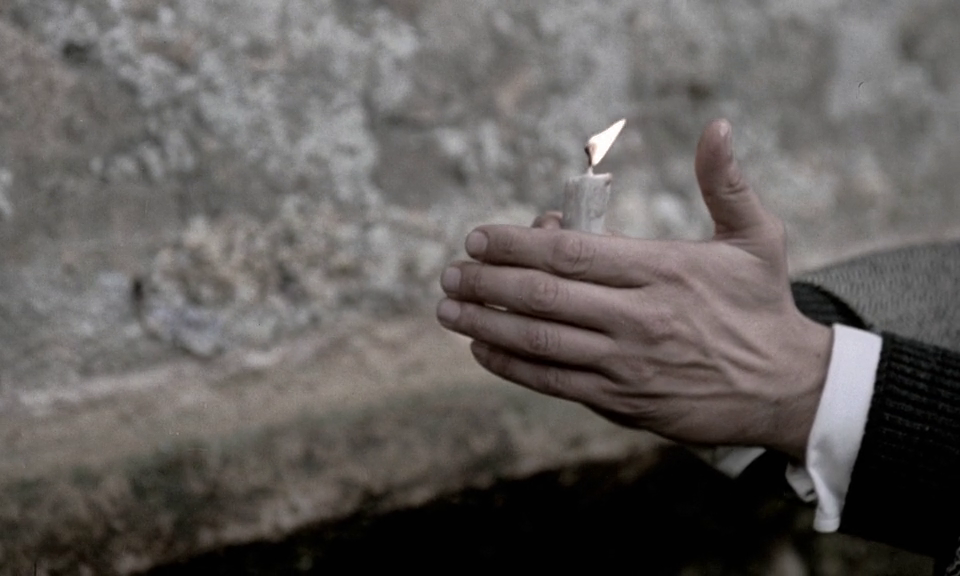
What happens when the reality of our character’s faith, hope and
obsessions are left to the viewers? What happens when films so clearly
intended to investigate the power and dimensions of faith are brought to
screen? The answer may be more than even Tarkovsky had set out to do.
His films are deeply spiritual, and it is clear that they have a great
effect on those who share his faith and beliefs.
At the same time, it is not at all the case that only people with
faith get something from his work. In many ways, they allow those of us
who do not share his ideas or beliefs to see the world through his eyes,
explore and empathize with those who believe and get powerful studies
that make us think and perhaps even re-examine how we see the world.
Be it understanding, camaraderie, empathy or even pity, these films
clearly reveal something different to so many different people as we
explore the very concept of faith and the people who have it, cling to
it and/or make sacrifices because of it.
This is perhaps what has made him so much more universally acclaimed
and even transcendental than many of his religious peers, such as Cecil
B. DeMille, who prefer to confirm their beliefs without any uncertainty.
Tarkovsky stands as one of the most respected figures in the history
of cinema, with a small, yet strong filmography. How he explored faith
is undoubtedly a key part of his success and why so many people, across
the world and across all faiths, beliefs or lack thereof have found a
way to connect with his work.




